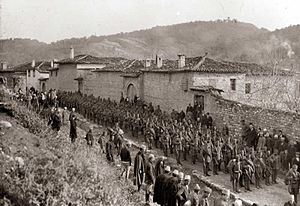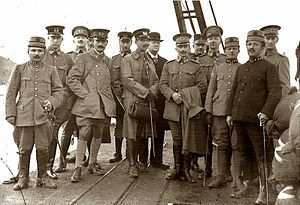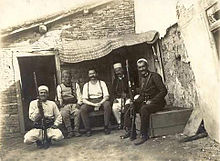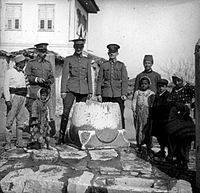- International Gendarmerie
-
International Gendarmerie 
Albanian Gendarmerie in southern Albania, 1913Active Country Principality of Albania Type Gendarmerie Role Law enforcement agency Commanders Colonel Willem De Veer Major Lodewijk Thomson The International Gendarmerie was the first law enforcement agency of the Principality of Albania. It was established by the decision of the ambassadors of the six Great Powers that participated in the London Peace Conference. This decision was made on the basis of the London Treaty signed on May 30, 1913. Since most of the members were from the Netherlands, this force was also known as the Dutch Military Mission.
The first gendarmerie members arrived in Albania on November 10, 1913. They were soon faced with a peasant revolt. One International Gendarmerie officer was killed and many were imprisoned after the revolt erupted in June 1914. Dutch officers were gradually replaced by officers from Austria-Hungary and Germany, who arrived in Durrës on July 4.[1] Soon, World War I broke out and by August 4, most of the Dutch officers had returned to the Netherlands. By September 19, 1914, the last two imprisoned officers were released.
Contents
Background
The ambassadors of the six Great Powers decided to constitute the Principality of Albania on July 29, 1913 during the 54th meeting of the London Conference.[2] The new country needed a sovereign, borders, government and military police force.[3] To ensure the gendarmerie's neutrality, the Powers decided that its members should come from a different country. Their first choice was Sweden, but that country was already busy with a similar mission in Persia, they chose the Netherlands for its neutrality, lack of direct interest in Albania and extensive colonial experience in the Dutch East Indies.[4] On October 15, 1913 they established the International Commission of Control to administer the country until its own political institutions were established.[5] Wilhelm of Wied was selected as the first prince.[6]
Leadership
 Captain Fabius, Major Kroon, Major De Waal (partly visible), Major Sluys, Captain Doorman, Major Roelfsema, Dr. De Groot (in civilian clothes), Captain Sar, Major Verhulst, Major Snellen van Vollenhoven and, far right, First Lieutenant Mallinckrodt on their arrival in Vlorë on February 24, 1914. The others are Albanian officers.
Captain Fabius, Major Kroon, Major De Waal (partly visible), Major Sluys, Captain Doorman, Major Roelfsema, Dr. De Groot (in civilian clothes), Captain Sar, Major Verhulst, Major Snellen van Vollenhoven and, far right, First Lieutenant Mallinckrodt on their arrival in Vlorë on February 24, 1914. The others are Albanian officers.
The Netherlands' War Minister initially chose Major Lodewijk Thomson to head the Gendarmerie, but after a Dutch unrelated political crisis and the formation of a new government, the new Minister appointed Colonel Willem De Veer instead, placing Thomson as his second-in-command on October 20, 1913.[7]
De Veer and Thomson prepared a classified 150-page report on the setting up of the gendarmerie. There were discussions of 5,000 gendarmes led by Dutch officers provided by the government of the Netherlands.[8] On February 24, 1914, 13 Dutch officers arrived at Vlorë: Captain Fabius, Major Kroon, Major De Waal, Major Sluys, Captain Doorman, Major Roelfsema, Dr. De Groot, Captain Sar, Major Verhulst, Major Snellen van Vollenhoven, First Lieutenant Mallinckrodt, Captains Reimers and Sonne.
Mission
The International Gendarmerie was only one of numerous armed groups in the principality during Wilhelm's reign.[9] Others included irregular bands of southerners led by local leaders; native outlaws; Bulgarian outlaw Komitadjis; Greek rebels from the Northern Epirus; peasant rebels in central Albania; Essad Pasha's gendarmerie; volunteers from Kosovo led by Isa Boletini;[10] and Mirdita Catholic volunteers from the northern mountains under the command of Prênk Bibë Doda.[11]
One of the first tasks of the new gendarmerie was to train Albanian recruits in order to take control of southern Albania after the Northern Epirote Declaration of Independence of February 28, 1914.[12]
Essad Pasha Toptani, as minister of war and interior, was against a peaceful solution of the problem. He opposed the International Commission of Control which believed that the problem could be solved by diplomatic means. The Prince and his cabinet accepted Essad Pasha's proposals for a military solution.[13] Several thousand Italian rifles and Austrian machine and mountain guns were purchased and distributed to the (predominantly Muslim) population of central Albania.[14] They believed that the new regime was a tool of the (Christian) Great Powers and the landowners that owned half of the arable land.[15] On the basis of those beliefs they revolted.
When thousands of rebels surrounded Shijak on May 17 (only 10 kilometers (6.2 mi) from Durrës), Essad Pasha was accused of fomenting the revolt against William of Wied.[16] He was exiled to Italy on May 20, without trial.[17][18]
The revolt intensified after Essad's exile.[19] In order to gain support from the 1,000 Mirdita Catholic paid volunteers[20] from the northern mountains, Prince of Wied appointed their leader, Prênk Bibë Doda, as foreign minister. Isa Boletini and his men, mostly from Kosovo also joined the International Gendarmerie to fight the rebels.[10] Dutch gendarmes together with the Mirdita attempted to capture Shijak, but when they engaged on May 23, they were surrounded and captured, along with another expedition from Durrës which attempted to release the captured gendarmes. Captain Sar did not know that the northern Catholic tribes refused to fight the rebels because General Besa was agreed when the Prince of Wied took over the throne.[21] Rebels attacked Durrës, firing on it with light weapons. The people in Durrës panicked and the Prince took his family to shelter in an Italian ship anchored in the bay.[22]
During the early morning surprise attack, on June 15, 1914 Thomson was shot in the chest (despite the fact that rebels were attacking behind him) and died within a few minutes.[23] It is probable that an Italian sniper was responsible.[24][25]
Captain Fabius established a volunteer artillery unit.[26] According to the Austrian government, the volunteers who bombarded the rebels were recruited by the Albanian Committee in Vienna.[27] Till the end of June 1914 Dutch officers were captured by rebels in most of the central Albania. They were gradually replaced with officers from Austria-Hungary and Germany, who arrived in Durrës on July 4.[28] On July 27, 1914 Colonel De Veer officially tendered the officers' resignations.[29] Soon the First World War broke out and by August 4 most of the officers had returned home. The rebels captured Berat on July 12 and Vlore, without fight, on August 21.[30] The last two captured officers (Verhulst and Reimers) were released on September 19, 1914.[31]
End of the Mission
In autumn 1914 Essad Pasha accepted an invitation from the Senate of Central Albania (established by the rebelling towns in mid and north Albania) to return to Albania to take control.[32] His first task was to provide financial backing for his government. Therefore he travelled to Niš, Kingdom of Serbia, where he and Serbian prime minister Pašić signed a secret treaty of Serbian-Albanian alliance on September 17.[33] In October 1914 Essad Pasha returned to Albania. With Italian and Serbian financial backing he established armed forces in Dibër and captured the interior and Durrës at the beginning of October, without a fight.[34]
See also
- International Commission of Control
- Wilhelm of Wied
- Peasant Revolt in Albania
- Lodewijk Thomson
Notes
- ^ Elsie, Robert. "Albania under prince Wied". Archived from the original on January 25, 2011. http://www.webcitation.org/query?url=http%3A%2F%2Fwww.albanianphotography.net%2Fen%2Fdmm.html&date=2011-01-25. Retrieved January 25, 2011. "Dutch officers ... were gradually replaced by... German and Austrian officers who arrived in Durrës on 4 July"
- ^ Elsie b
decision, reached at the fifty-fourth meeting of the conference on 29 July 1913...Albania is constituted as an autonomous, sovereign and hereditary principality by right of primogeniture, guaranteed by the six Powers.
- ^ Elsie a
In July 1913, the newly recognized principality of Albania needed not only a sovereign, but also fixed borders, a government and – what was of no small significance – a military police force to guarantee the prince’s rule and to ensure law and order in the country. The Conference of Ambassadors resolved that public order and security should be assured by an internationally organised gendarmerie.
- ^ Elsie a
Swedish army... was, however, busy with a similar mission in Persia, so the choice then fell upon the Netherlands, in particular because the country was neutral, had no direct interests in Albania, and no doubt because it had a good deal of colonial experience in the Dutch East Indies
- ^ Zaharia, Perikli (March 24, 2003). "The post – 1989 constitutional course of south east europe". Athens: Centre for European Constitutional Law. Archived from the original on January 22, 2011. http://www.webcitation.org/query?url=http%3A%2F%2Fwww.cecl.gr%2FRigasNetwork%2Fdatabank%2FREPORTS%2Fr23%2FZAHARIA.html&date=2011-01-21. Retrieved January 22, 2011. "Treaty of May 30, 1913. As it was decided at the London Conference of Ambassadors,..., an International Control Commission was created."
- ^ Seton-Watson, R.W. J. Dover Wilson, Alfred E. Zimmern, and Arthur Greenwood (January 10, 2004) [1915] "III Germany" The War and Democracy London: MacMillan And Co. Ltd.; 1st Edition http://www.gutenberg.org/files/10668/10668.txt "Prince William of Wied, the first Prince of Albania"
- ^ Elsie b
Lodewijk Thomson ... Before his appointment as head of the Dutch mission to Albania could be finalized... the choice was finally made, by a Royal Decree of 20 October 1913, it fell upon Colonel Willem De Veer
- ^ Teunissen b
Thomson and De Veer .. investigate how a gendarmerie could be set up. Their 150-page classified report..approximately 5,000 gendarmes was also discussed. .. Dutch government to provide officers to lead the gendarmerie force.
- ^ Heaton-Armstrong 2005
Southerners, whose local leaders... irregular bands ..native and Bulgarian “Komitadjis” (an outlaw or brigand)...“Royal” (Essad Pasha’s Own) mounted gendarmes.. Epirotes...troops... peasants...insurgents
- ^ a b Elsie a
volunteers from Kosova under their leader Isa Boletini
- ^ Elsie a
volunteers from Catholic Mirdita and the northern mountains under Simon Doda, nephew of Prenk Bibë Doda
- ^ Teunissen a
Wied’s first order of business was to restore order in South Albania. The Dutch officers were faced with an almost impossible task. ... they had to train Albanian gendarmes and non-commissioned officers
- ^ Heaton-Armstrong 2005
Essad Pasha, as Minister for War, was opposed to any compromise with the insurgents and assured the Mbret that the rebellion could easily be put down by force of arms; .
- ^ Heaton-Armstrong 2005
The Government had purchased several thousand modern military rifles in Italy, machine and mountain guns in Austria and now thought itself strong enough to conquer the greater part of the world. The Mahommedan population of central Albania was to be armed and with this imposing new army behind him, Essad Pasha hoped to sweep all before him; at least he said that he would. .
- ^ Jelavich, Barbara (1999) [1983] History of the Balkans: Twentieth century 2 Cambridge, United Kingdom: The Press Syndicate of University of Cambridge p. 103 ISBN 0-521-27459-1 http://books.google.com/books?id=Hd-or3qtqrsC&pg=PA100&dq=albanian+congress+in+trieste+1913#v=onepage&q&f=false. Retrieved January 25, 2011 "peasants..willing listeners to Ottoman propaganda... attached the new regime as a tool of the beys and Christian powers"
- ^ Elsie a
It was obvious to Wied and the Dutch officers that Essad Pasha had his hand in the unrest.
- ^ Heaton-Armstrong 2005
Essad would be sent into exile, without a trial.
- ^ Elsie a
to exile Essad Pasha to Italy
- ^ Vickers 1999
- ^ Teunissen a
The Malisors, paid volunteers from the mountain tribes of North Albania, grew to include 1,000 men
- ^ Elsie a
general besa (cease-fire) had been agreed on the occasion of Wied’s accession to the throne...
- ^ Elsie a
Panic broke out in Durrës, and the royal family sought refuge on an Italian vessel ....
- ^ Teunissen c
Early in the morning of 15 June,... Thomson ...was hit in the chest, although the attack was taking place behind him.
- ^ Elsie a
..rumoured, an Italian sniper was behind his death ...
- ^ Heaton-Armstrong 2005
According to the most detailed analysis of the circumstances ... he was probably killed by an unidentified Italian sniper, not Moslem rebels. (Goslinga, Gorrit T A. The Dutch in Albania. Rome, 1972, pp. 42–45)
- ^ Teunissen a
Fabius formed an artillery unit of volunteers
- ^ Vickers 1999, p. 85
As the angry crowd neared the capital Austrian officers bombarded them. According to the Austrian government, those Austrian officers were volunteers recruited by "Albanian Committee" in Vienna.
- ^ Elsie a
Dutch officers ... were gradually replaced by... German and Austrian officers who arrived in Durrës on 4 July
- ^ Elsie a
De Veer...formal resignation and that of his men...officially on 27 July 1914
- ^ Elsie a
situation was not much better for the Dutch officers in the other parts of the country. ...Berat fell to the rebels on 12 July and Vlora was occupied without a struggle on 21 August.
- ^ Elsie a
Verhulst and Reimers were released in Shijak on 19 September and departed for Holland the next day.
- ^ Bataković 1992
The senate of free towns in central Albania invited Essad to take over power.
- ^ Bataković 1992
Essad Pasha signed a secret alliance treaty with Pasic on September 17.
- ^ Bataković 1992
Essad Pasha mustered around 5,000 Albanian volunteers, crossed over to Albania and entered Durazzo at the beginning of October without strife.
References
- Bataković, Dušan T. (1992) "Serbian government and Essad Pasha Toptani" The Kosovo Chronicles Belgrade, Serbia: Knižara Plato ISBN 86-447-0006-5 archived from the original on January 19, 2011 http://balkania.tripod.com/resources/history/kosovo_chronicles/kc_part2e.html. Retrieved January 19, 2011
- Elsie, Robert (a). "Albania under prince Wied". Archived from the original on January 25, 2011. http://www.webcitation.org/query?url=http%3A%2F%2Fwww.albanianphotography.net%2Fen%2Fdmm.html&date=2011-01-25. Retrieved January 25, 2011.
- Elsie, Robert (b). "The Conference of London". Archived from the original on February 11, 2011. http://www.webcitation.org/query?url=http%3A%2F%2Fwww.albanianhistory.net%2Ftexts20_1%2FAH1913_2.html&date=2011-02-11. Retrieved February 11, 2011.
- Heaton-Armstrong, Duncan (2005). "An Uprising in the Six-Month Kingdom". Gervase Belfield and Bejtullah Destani (I.B. Tauris, in association with the Centre for Albanian Studies). Archived from the original on January 25, 2011. http://www.webcitation.org/query?url=http%3A%2F%2Fwww.albanianhistory.net%2Ftexts20_1%2FAH1914_2.html&date=2011-01-25. Retrieved January 25, 2011.
- Heaton-Armstrong, Duncan (2005) The six month kingdom: Albania 1914 London: I.B. Tauris & Co. Ltd. ISBN 1-85043761-0 http://books.google.com/books?id=LqXn2WqOzgwC&pg=PA94&dq=international+gendarmerie+in+Albania+1914#v=onepage&q&f=false. Retrieved February 11, 2011
- Teunissen, Harrie (a). "The fight in South Albania". siger.org. Archived from the original on February 12, 2011. http://www.webcitation.org/query?url=http%3A%2F%2Fwww.siger.org%2Falbania%2Fen%2Farea-14-the-fight-in-south-albania-continued%2F&date=2011-02-12. Retrieved February 12, 2011.
- Teunissen, Harrie (b). "[http://www.siger.org/albania/en/area-11-the-creation-of-the-albania-mission/ "he creation of the Albania mission"]. siger.org. Archived from the original on February 12, 2011. http://www.webcitation.org/query?url=http%3A%2F%2Fwww.siger.org%2Falbania%2Fen%2Farea-14-the-fight-in-south-albania-continued%2F&date=2011-02-12. Retrieved February 12, 2011.
- Teunissen, Harrie (c). "[http://www.siger.org/albania/en/area-18-the-battle-of-Durrës/ The battle of Durrës"]. siger.org. Archived from the original on February 12, 2011. http://www.webcitation.org/query?url=http%3A%2F%2Fwww.siger.org%2Falbania%2Fen%2Farea-14-the-fight-in-south-albania-continued%2F&date=2011-02-12. Retrieved February 12, 2011.
- Vickers, Miranda (1999). The Albanians: a modern history. I.B.Tauris. ISBN 978-1860645419. http://books.google.com/books?id=IzI0uOZ2j6gC.Bataković, Dušan T. "Serbian government and Essad Pasha Toptani" The Kosovo Chronicles Belgrade, Serbia: Knižara Plato ISBN 86-447-0006-5 archived from the original on January 19, 2011 http://balkania.tripod.com/resources/history/kosovo_chronicles/kc_part2e.html. Retrieved January 19, 2011 "The senate of free towns in central Albania invited Essad Pasha to take over power."
External links
- Colonel Thomson and Albania, Harrie Teunissen
Categories:- History of modern Albania
- 1913 in Albania
- Gendarmerie
Wikimedia Foundation. 2010.


